When I dug up and divided these iris rhizomes I found that I had a problem with the iris borer that was bigger than I had estimated this past summer while doing some inspections in the garden. After tossing away the rhizomes that were infected by this pest I cut down the leaves to make sure any iris borer larvae that remained had less places to overwinter.
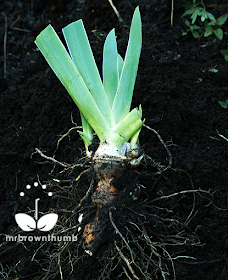 While replanting these I made sure the exposed rhizomes were facing south to receive as much sun as possible. I placed them on small mounds above the soil level as recommended, and spread the roots out to give them space to grow.
While replanting these I made sure the exposed rhizomes were facing south to receive as much sun as possible. I placed them on small mounds above the soil level as recommended, and spread the roots out to give them space to grow.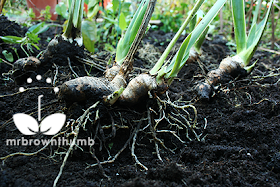 A side view to illustrate the soil mounds mentioned above. See how they raise the iris rhizomes higher than the ground? Make the mounds a good height because the soil will settle when you water or it rains and if they sink below a couple of inches they may rot. If you're planting them in a low spot in your garden where water is prone to pool, make your mounds even higher to accommodate any settling.
A side view to illustrate the soil mounds mentioned above. See how they raise the iris rhizomes higher than the ground? Make the mounds a good height because the soil will settle when you water or it rains and if they sink below a couple of inches they may rot. If you're planting them in a low spot in your garden where water is prone to pool, make your mounds even higher to accommodate any settling. Once the rhizomes were positioned properly, I filled the area with garden soil making sure to cover the roots and leave just the rhizome divisions exposed.
Once the rhizomes were positioned properly, I filled the area with garden soil making sure to cover the roots and leave just the rhizome divisions exposed.The best time to plant bearded irises in your garden is July-September, because this gives them time to become established before winter and bloom the following spring. When I first planted the single rhizome that all of these, there's more than what's pictured here, came from I planted it in the fall because that's when I bought it and it bloomed the following spring. Irises are such low-maintenance perennials, perfect for beginner gardeners, that I recommend everyone should grow some.
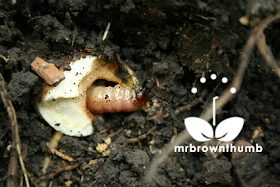 Larvae of the iris borer that I found this summer in my garden. If you notice your iris rhizomes are rotting you may have some of these pests attacking your iris clumps.
Larvae of the iris borer that I found this summer in my garden. If you notice your iris rhizomes are rotting you may have some of these pests attacking your iris clumps.

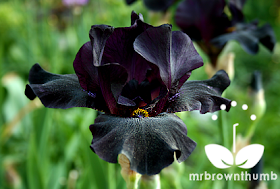
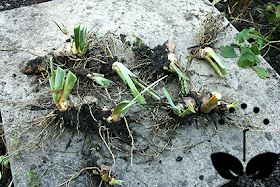
Very nice post and helpful too.
ReplyDeleteLove those Black Iris but wish you'd put a warning before the photo of the Iris Borer, Mr Brown Thumb! Haven't seen one in a decade but the sight can still make me queasy.
ReplyDeleteIris expert Florence Stout once taught gardeners how to plant iris by comparing the rhizome to a swimming dog. The image stuck, so I try to get the paws deep underwater, the back barely covered and keep the head up!
Annie at the Transplantable Rose
Hi Urban Green,
ReplyDeleteGlad you found the post helpful.
Annie,
Ha! I thought maybe I was just particularly squeamish or something.
Thanks for the tip from Florence Stout, that's is probably the easiest to understand explanation I've ever heard.
The 'black' iris is amazing - I've never seen it before.
ReplyDeleteI posted about the iris borer in July, when I was waging war against them and grossed people out, too. (Boring Irises) Heck, I was grossed out. These are such a problem, that I tell people, "If you've got irises and have had them for any time at all, you've got borers. I'd just about bet my life on it."
ReplyDeleteThis is a great post with lots of good information and tips!
Oh, forgot to add that I LOVE your black iris. I fell in love with them at Spring Fling, when I saw one at the Art Institute's north garden. I need to get one!
ReplyDeleteHi Evelyn,
ReplyDeleteGlad you liked it and thanks for stopping by.
Kylee, over on my FB page I mentioned the one at the AI and how beautiful and truly black it was. I really wanted to take a division of it one day under the cover of dark. :0)
If you do decide to relocate part of a certain black iris, remember how well you like me, okay? ;-)
ReplyDeleteHaha, will do. :0)
ReplyDeleteI was going to repot some of my irises. I wonder if irises growing in containers are more/less susceptible to those borers. YUCK!
ReplyDeleteYour black iris is gorgeous! If I had more sun, that one would definitely be on my must-have list.
ReplyDeleteGreat post, very informative, we need more of these.
ReplyDeleteTyra
We're having a very odd autumn--or lack of it--this year but a friend of mine has found her yellow irises are reblooming. They aren't a reblooming variety so she's fascinated by this little gift.
ReplyDeleteHi Fern,
ReplyDeleteDunno if they're more susceptible in containers, but I'd say it is probably an advantage to grow them in containers. I say this because closer to eye-level it may be easier to spot the borer going into the leaf, than if they were planted in the ground.
Garden Girl & Tyra
Thanks, glad you like it.
Jodi,
Sounds like the kind of problem I'd like to have. :0) I wouldn't mind seeing these bloom twice a year.
MBT, that is one gorgeous iris! If you ever want to trade a piece of it for an unnamed giant pink one, please let me know! seriously!
ReplyDeleteQuestion: My iris plot has sunk over the years. Still blooming beautifully, but I am starting to worry that they will all rot and I will lose a big chunk of the bed. Do you recommend just biting the bullet and digging the whole thing up and redoing it with more "dirt" and setting them on new little mounds of "swimming dogs"? thanks.
Your "Black Iris" is absolutely beautiful. I love it. I grew some irises years ago and wondered why they disappeared. Now I think I know. It's because I may have planted them too deeply. I think I will try to plant some Irises again, because I really do love them, and would love to have some in my perennial garden. Thanks for sharing your picture of this beautiful flower.
ReplyDeleteThanks for sharing this picture of a beautiful "Black Iris". I am very impressed, and it makes me want to go to the garden store right now, and buy myself another iris plant. In fact, I think I will just leave work at lunchtime today and go buy myself a new Iris plant.
ReplyDeleteI just shared the first photo on facebook - I'm simply astonished at the sight of a black iris. If you'd prefer I remove it, I will; but the post does link back to your blog. Which I love.
ReplyDeleteYesterday while weeding I realized I needed to dig these up the rhizomes because deep grassy weeds were imbedded in them. I want to till the soil and replenish it. How long can I leave the rhizomes out of the soil?
ReplyDeleteWell, there you go. You just answered all my questions about planting and dividing Iris. Thank you.And your pictures are georgeous!
ReplyDeleteMr. Brown Thumb, you take the most beautiful photos! Your step-by-step illustrations are so helpful. I'm writing a blog post on bearded iris as a favor to a friend and am ill-prepared in the photo department. I hope it's okay that I mention your blog for further, detailed planting instructions?
ReplyDeleteAnne
Hi Anne,
Deletethanks for the compliment. No, I don't mind if you reference my post on replanting iris rhizomes.
I just this morning dug up a whole bed of irises that didin't flower...your warnings about the iris borer was timely. I found that little critter - so dug up ALL the irises (and the all the grass that was entwined!!) threw out those that had been attacked and will position them in a new spot with fresh soil. As I am in Australia there is not shortage of sun ..do I need to feed them or compost the soil before I replant? I am really looking forward to seeing what colours I have in this lot so fingers crossed that they flower next season. Thank you SO much for this posting
ReplyDeleteDo you know the reason for leaving the rhizomes exposed to the sun or just below soil level...why would it affect the flowering? I watched a garden show where they said that photosynthesis takes place in the rhizome - I cannot find anything to corroborate this - possibly you may know? Thanks very much for your posting.
ReplyDelete